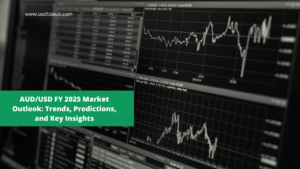The exchange rate between the Australian Dollar (AUD) and the U.S. Dollar (USD) is a significant concern for investors, businesses, and individuals engaged in trade or travel between Australia and the United States. Fluctuations in this exchange rate can have a profound impact on trade balances, investment decisions, and overall economic stability for both countries.
The question of whether the AUD to USD exchange rate is going to improve in the near future requires an analysis of a variety of factors, including economic indicators, government policies, global market trends, and geopolitical events.
In this article, we will explore the factors that influence the AUD/USD exchange rate, analyze recent trends, and discuss potential scenarios for the future. We will also present key economic data and conclude with expert insights on whether the AUD is likely to improve against the USD.
The AUD to USD Exchange Rate
The AUD/USD currency pair reflects how much one Australian Dollar is worth in U.S. Dollars. This exchange rate plays a crucial role in determining the cost of goods and services between the two countries, influencing everything from exports and imports to investments and tourism.
When the AUD strengthens against the USD, Australian exports become cheaper for U.S. consumers, while U.S. goods become more expensive for Australians. Conversely, when the AUD weakens against the USD, the opposite occurs.
Understanding the future movements of the AUD/USD exchange rate requires an analysis of both domestic factors in Australia and external factors such as global economic conditions, monetary policy, and the performance of other major currencies like the Euro (EUR) and the Japanese Yen (JPY).
Key Factors Influencing the AUD/USD Exchange Rate
1. Interest Rates and Monetary Policy
One of the most significant factors that influence exchange rates is the interest rate differential between two countries. The Reserve Bank of Australia (RBA) and the Federal Reserve in the U.S. set benchmark interest rates, which directly impact the attractiveness of each country’s currency to foreign investors.
- RBA’s Policy: The Reserve Bank of Australia adjusts interest rates based on the domestic economic situation, aiming to keep inflation within a target range. Higher interest rates typically attract foreign capital, which can lead to a stronger AUD.
- Federal Reserve’s Policy: Similarly, the Federal Reserve’s monetary policy decisions are key to the value of the USD. In recent years, the U.S. has adopted a policy of raising interest rates in response to inflationary pressures, which has helped support the value of the USD.
As of late 2024, both central banks are expected to follow similar paths with respect to interest rates, though the U.S. Federal Reserve’s actions may have a more significant impact due to the dollar’s global reserve currency status.

2. Commodity Prices and the Australian Economy
Australia is a major exporter of commodities such as iron ore, coal, and natural gas. The performance of these commodities has a direct impact on the strength of the AUD. When global demand for commodities is strong, Australia’s trade balance improves, which can lead to a stronger AUD.
- China’s Demand for Commodities: China, as Australia’s largest trading partner, plays a crucial role in determining the demand for Australian commodities. A slowdown in China’s economic growth could reduce demand for Australian exports, which could weaken the AUD.
- Global Economic Conditions: The performance of other global economies, especially emerging markets, also impacts commodity prices. If global economic growth slows down, commodity prices tend to fall, potentially leading to a weaker AUD.
3. Global Risk Sentiment
The AUD is considered a “risk-sensitive” currency, meaning its value tends to rise in times of global economic optimism and fall during periods of uncertainty. In times of market turbulence or geopolitical instability, investors often flock to the USD as a safe haven. This can result in the AUD depreciating against the USD during crises.
- Global Economic Growth: Strong global economic growth tends to favor the AUD, as it boosts demand for Australian exports. Conversely, economic slowdowns or recessions, especially in major economies, could lead to a weakening of the AUD.
- Geopolitical Events: Events such as trade wars, political instability, and conflicts in the Asia-Pacific region can lead to fluctuations in the AUD/USD exchange rate. These events can cause investors to seek refuge in the USD, driving its value higher.
4. Trade and Fiscal Policies
The balance of trade (exports minus imports) is another important factor influencing the exchange rate. Australia’s trade surplus or deficit can affect the value of the AUD. A trade surplus typically supports the AUD, while a trade deficit can lead to a weaker AUD.
- Australia’s Trade Balance: If Australia continues to experience a trade surplus, the AUD could strengthen against the USD. On the other hand, a widening trade deficit could put downward pressure on the AUD.
- Fiscal Policies in the U.S. and Australia: Fiscal policies, such as government spending and taxation, can also play a role. U.S. fiscal policies, especially if the government runs large deficits, can result in increased borrowing, which might weaken the USD. Conversely, Australia’s fiscal policies could affect investor confidence in the AUD.
5. Inflation and Economic Growth
Inflation rates in both countries affect the relative purchasing power of their currencies. If inflation in the U.S. remains higher than in Australia, the US Dollor could weaken. On the other hand, if inflation in Australia rises faster than in the United States , the AUD could depreciate.
- Economic Growth in Australia: Australia’s economic performance, including GDP growth, employment rates, and consumer spending, also impacts the AUD. A strong economy typically leads to a stronger currency, while a weaker economy may result in a weaker currency.
- U.S. Economic Growth: The U.S. economy is one of the largest in the world, and its performance significantly influences the USD. Strong economic growth in the U.S. can boost investor confidence in the USD, leading to a stronger exchange rate against the AUD.
Historical Trends: AUD to USD
To understand the potential for future improvements in the AUD/USD exchange rate, it’s helpful to look at historical trends. The Australian Dollar has experienced significant fluctuations against the U.S. Dollar over the years.
Historically, the AUD has been subject to both short-term volatility and long-term cycles influenced by global economic conditions, commodity prices, and monetary policy.
Below is a table illustrating the historical performance of the AUD/USD exchange rate over the past decade:
| Year | AUD to USD Exchange Rate |
|---|---|
| 2014 | 0.89 |
| 2015 | 0.72 |
| 2016 | 0.75 |
| 2017 | 0.77 |
| 2018 | 0.72 |
| 2019 | 0.69 |
| 2020 | 0.66 |
| 2021 | 0.73 |
| 2022 | 0.71 |
| 2023 | 0.65 |
As seen in the table, the AUD/USD exchange rate has been highly volatile in recent years, primarily due to global events such as the COVID-19 pandemic and fluctuating commodity prices.
In particular, the decline in 2020 was tied to the economic impact of the pandemic, while the recovery in 2021 was driven by the rebound in global trade and commodity prices.
Predictions for the Future: Will the AUD Improve Against the USD?
Looking ahead, predicting the future direction of the AUD/USD exchange rate is challenging, as it depends on numerous factors, including interest rates, global economic conditions, and commodity prices.
However, we can outline several potential scenarios for the future:
Scenario 1: Stronger AUD Due to Economic Recovery and Rising Commodity Prices
If global economic conditions improve, particularly in key regions like China and Asia, and if commodity prices continue to rise, there is potential for the AUD to strengthen against the US Dollor.
Australia’s strong trade surplus, combined with higher interest rates from the RBA, could also contribute to a stronger AUD.
Scenario 2: Weak AUD Due to Global Economic Uncertainty
On the other hand, if global economic conditions deteriorate, especially in China, and if the U.S. dollar remains the safe haven of choice during times of uncertainty, the AUD may face downward pressure.
Additionally, if the RBA adopts a dovish stance on interest rates while the Federal Reserve continues to raise rates, the AUD could weaken further.
Scenario 3: Stable AUD with Modest Movements
The AUD/USD exchange rate could also remain relatively stable, with modest fluctuations driven by changes in commodity prices and interest rates.
In this scenario, the AUD may trade within a range, neither significantly improving nor deteriorating against the USD.

Conclusion
The future of the AUD/USD exchange rate depends on a variety of factors, including interest rate differentials, commodity prices, economic growth, and geopolitical events. While there are potential scenarios in which the AUD could improve against the USD, the global economic landscape remains uncertain.
As of 2024, the outlook for the AUD is mixed, and while some experts predict modest improvements, others caution that risks to the global economy could put downward pressure on the Australian Dollar.
FAQs
1. What affects the AUD/USD exchange rate?
The AUD/USD exchange rate is influenced by interest rates, economic growth, commodity prices, trade balances, and global market sentiment.
2. Is the Australian Dollar expected to strengthen in the near future?
The Australian Dollar’s strength will depend on factors such as commodity price performance, the Australian economy’s growth, and the Federal Reserve’s monetary policy. The outlook is mixed.
3. How do global events impact the AUD/USD exchange rate?
Global events such as geopolitical crises, economic downturns, and changes in trade policies can lead to shifts in investor sentiment, which in turn affects the AUD/USD exchange rate.
4. Can the Reserve Bank of Australia influence the AUD/USD rate?
Yes, the Reserve Bank of Australia’s monetary policy decisions, particularly regarding interest rates, can significantly impact the value of the AUD against the USD.
5. What role do commodity prices play in the AUD/USD rate?
Australia is a major exporter of commodities. When global demand for commodities rises, the Australian economy benefits, often leading to a stronger AUD. Conversely, a fall in commodity prices can weaken the AUD.

















